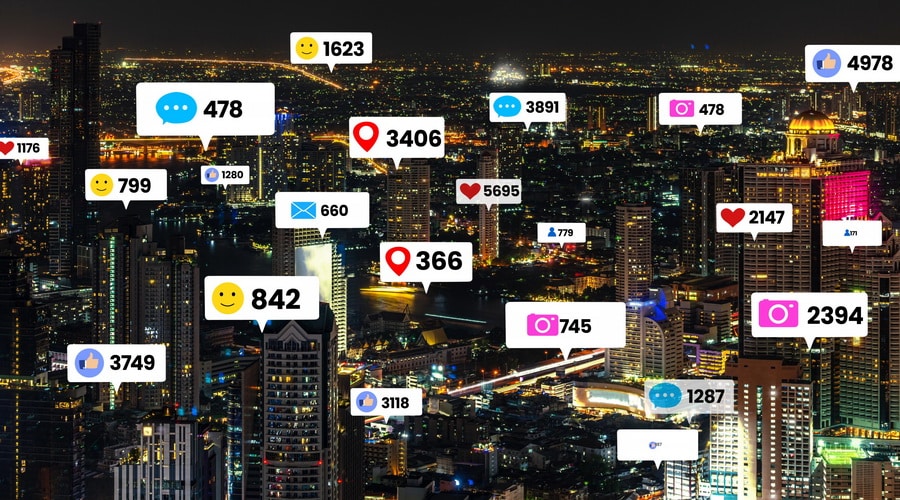Influencer Marketing: How to Make Your Application Stand Out

People do everything online: they communicate, shop, hunt for information, etc. On the face of it, the Internet seems to give us everything we need. But in reality, a lot of us feel a lack of in-person communication.
This duality has given ultramodern companies the opportunity to think about new ways to attract their target audiences with influencers.
What is Influencer Marketing?
Influencers are people who are considered experts in a particular subject or have an impact on large groups of people. They have a strong influence on Generation M to Z. Working with influencers is now a separate branch of marketing, called influencer marketing – promoting a product through an influencer’s personal brand.
Influencer marketing is more delicate and less protrusive than traditional advertising. Influencers do not persuade consumers to buy a certain product – rather, they recommend it from their own personal experience. For companies, the trust placed upon influencers and the implicit consumerism they create is appealing. They can be bloggers, YouTubers, Instagrammers, or TikTok personalities. Whatever their chosen platforms, influencers come in all shapes and sizes — from Micro to Macro influencers, categorized by number of subscribers:
- Macro influencers – over 1 million.
- Mid-tier influencers – between 100,000 and a million.
- Micro influencers – between 5,000 and 100,000.
- Mega-influencers, Nano-influencers, etc.

An influencer can be anyone who has a following, often built as a result of their expertise and online persona. However, influencer marketing isn’t just about followers: make sure to consider your ad spend when choosing your influencer.
Benefits of Influencer Marketing for Mobile App

App marketers can use the power of influencers to promote their apps. There are advantages to using influencer marketing for your Mobile App:
- Influencer marketing is good for small businesses. Before, only big businesses could afford to attract large influencers in advertising. But today, even small companies can collaborate with local bloggers to promote their products.
- Influencer marketing can increase sales. In a post or video description, the influencer leaves a link to the app that they promote, providing a direct traffic stream. Trust in opinion leaders boosts conversion in comparison to traditional user acquisition methods.
- You get closer to your target audience. Collaboration with influencers leads to communication with your audience. Nowadays, Most teenagers trust YouTube influencers more than traditional celebrities.
- Most of all, you can promote literally any type of app. There are no limits. All you have to do is choose a popular influencer with a large base of followers and start your campaign.

How to Find and Choose Mobile App Influencers?
To find your ideal influencer, review keywords related to your app and industry and look for blog posts to find relevant content. You can also use influencer marketing tools and influencer-specific agencies to find the influencer that fits best with the app and campaign you are promoting.
There are several key types of influencers:
- Networkers – with a large number of connections.
- Opinion leaders – understand their niche, which influences group members.
- Discoverers – interested in new products, always on trend and looking for new niches.
- Social media influencers – make regular posts about specific topics they have an expertise in on social media channels and generate followers.
- Sharers – share information on various channels.
- Users – work with standard brands.
When choosing the influencer you need to drive an app campaign, a lot of mobile marketers focus on candidates who have a high following. They think a high following will get them a wider reach and in turn, more installs. However, for influencer marketing campaigns to be successful for your app, you have to partner up with someone with a high engagement rate. Engagement rates show that influencers have strong relationships with their audience and encourage their buying decisions. The trick isn’t to post as much as possible in a small time frame, it’s reaching out to the right audiences, at the right time, with the right content. Influencers who promote apps too often lose value as they share too much promotional content. You should choose an influencer who can strike the right balance between consistency and quality.
More importantly, you should know your audience. Find out what they like, what they don’t like, and where they are most likely to be. You should know how they want to be engaged and what they are looking for in your app. This will help you understand their needs and interests better and choose your influencer accordingly.

App Influencer Marketing Strategies
A big concern for companies is knowing if they can trust the impact the influencer will have on the audience.
There are a few strategies you can use to be impactful:
Giving away discount codes
Apps can drive installs by offering discount codes to an influencer’s followers. This is the easiest influencer Marketing strategy. It’s widely used, by McDonald’s or Domino Pizza’s for example, who also give discount coupons.
APP and Product(Item) review
Apps can send influencers items and gift codes so that they can be featured on the influencer’s social media channels. Specifically with game apps, you can increase the desire to purchase features by showing limited items to consumers.
Play review
Perhaps one of the most common types of app promotion on YouTube are the “Let’s Play” types of videos. There, influencers go through the App by showing its features, commenting on their actions, and sharing it all in video format. This way introduces everything from installing to using the app. It is said to be one of the most efficient strategies.
Joint event
Mobile apps with multiplayer access are very well suited to influencer marketing. SuperCell, for example, holds an app gamer ‘Clash of Clans’ tournaments and the winners share a $1,000,000 prize. Influencers are likely to play and promote your app for prizes and money.

About the Risk: Influencers and Trust
Many influencers are very transparent about what they’re doing: they disclose when a post is an ad, they explain the process behind making content, and some even share how much money they make from their sponsored posts. But others can be dishonest and less likely to disclose if they have been paid by the company, for example.
There is no way of knowing for sure that the person we’re following online is being authentic. On social media, most people choose to only share positive things about their lives and leave out life’s difficult moments. Influencers are just the same, and they’re very likely to curate a perfect life if they have thousands of followers.
Due to these problems, the Advertising Standards Authority of Ireland has released guidelines for influencers that state they should always tell their audience if a post or content is an ad. They can mention it in their content or write hashtags like #ad or #Sponsored in their post or video description. Laws and provisions on stealth marketing are being strengthened in Korea and Japan as well. Of course, the guidelines vary from country to country, but transparency is becoming increasingly important in influencer marketing.
An influencer isn’t going to rave about your app service just because you paid for it. This is not how influencer marketing works. Influencers will give their opinion directly to their audience. It’s their role. By giving guidelines and content to influencers, you can prevent negative feedback.
Questions around authenticity and trust have long accompanied influencer marketing and will continue to do so in this field. That’s why, when selecting influencers, you should always keep in mind that the number of followers does not mean you’ll get good ROI — focus on signs of the Trust Threshold. Audiences can voice their distrust about influencers at any time, so don’t forget to check comments and reviews!

Closing Thoughts
Because consumers are placing increased importance on reviews when downloading your app, content from influencers is becoming more useful for app businesses looking to influence purchase decisions. Yet the relationship between influencers and their audiences is only as valuable as the amount of trust consumers have for the influencers they follow. Many factors can impact trust, everything from the kind of platform and channel itself, to how many times and how often influencers are posting. Here, we are talking about marketing, and we shouldn’t forget that this is a competition. While an informed strategy is needed to optimize trust, app marketers should also be aware of the volatile nature of social media and be constantly working to own their reliable influencer lists so they can adjust to rapid changes.









